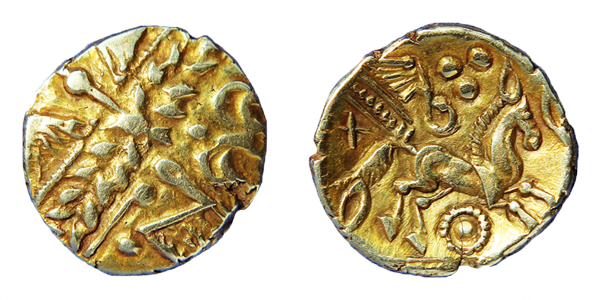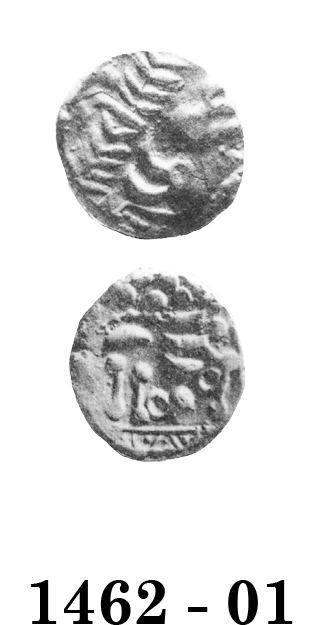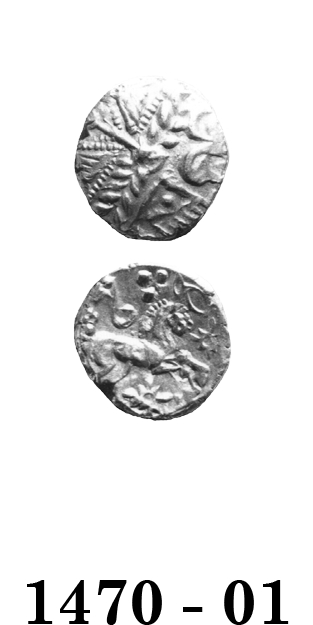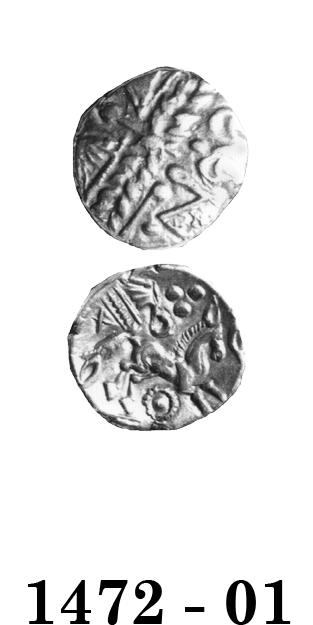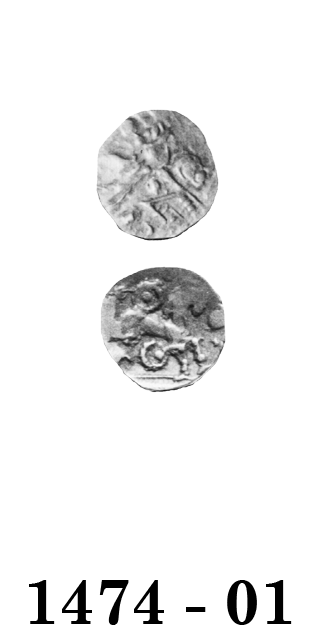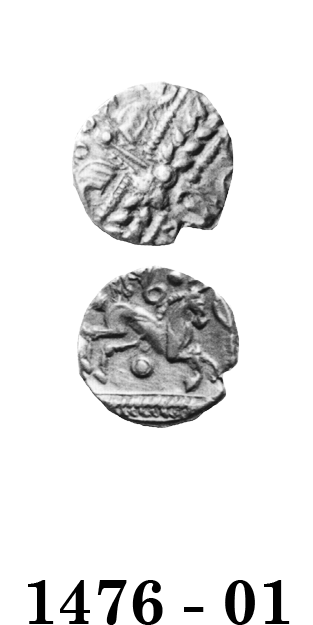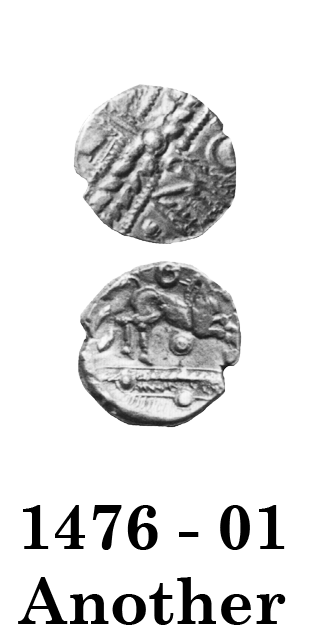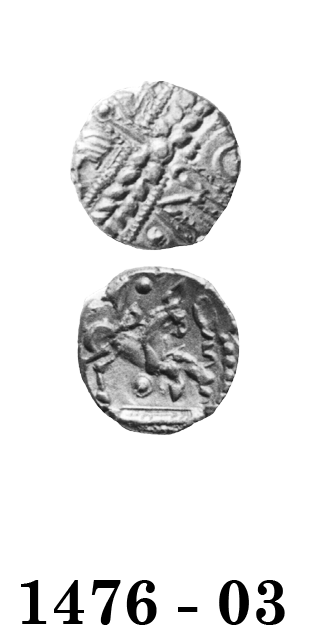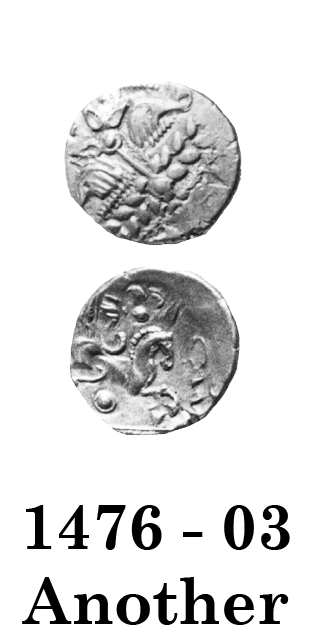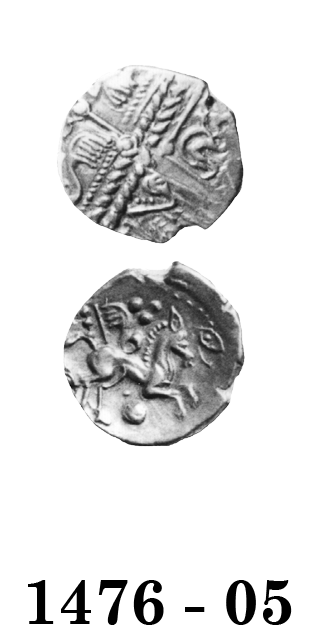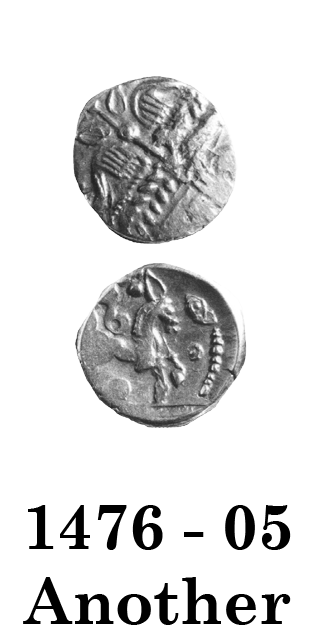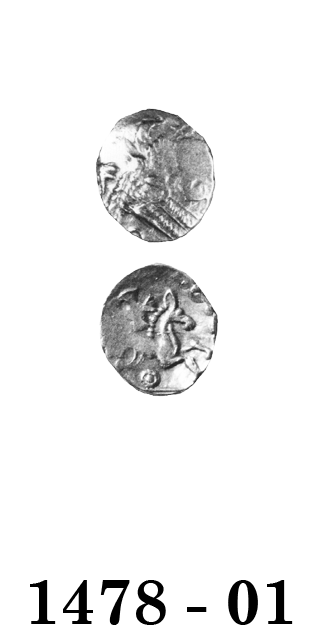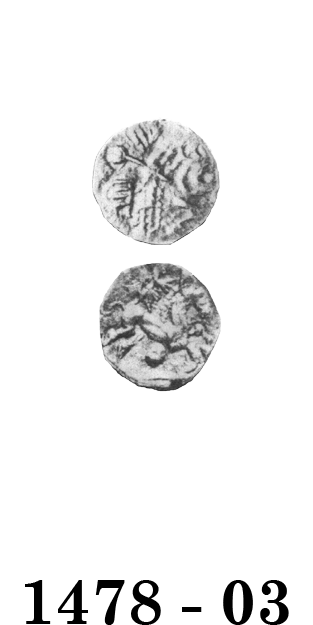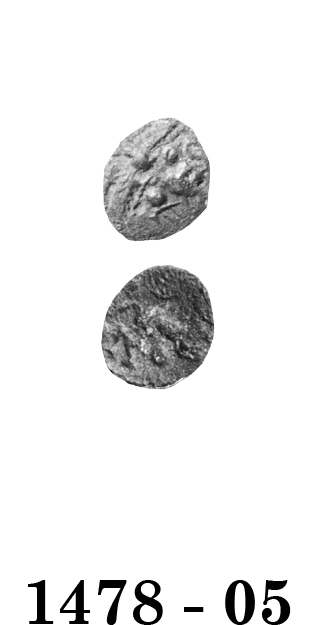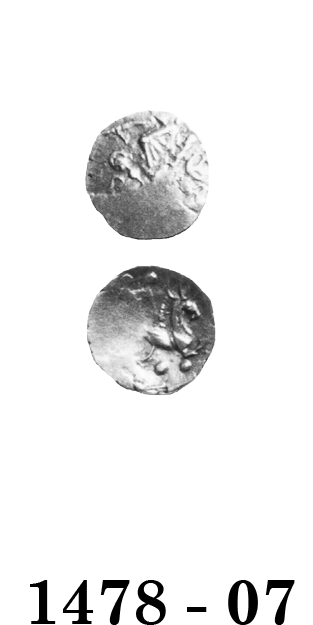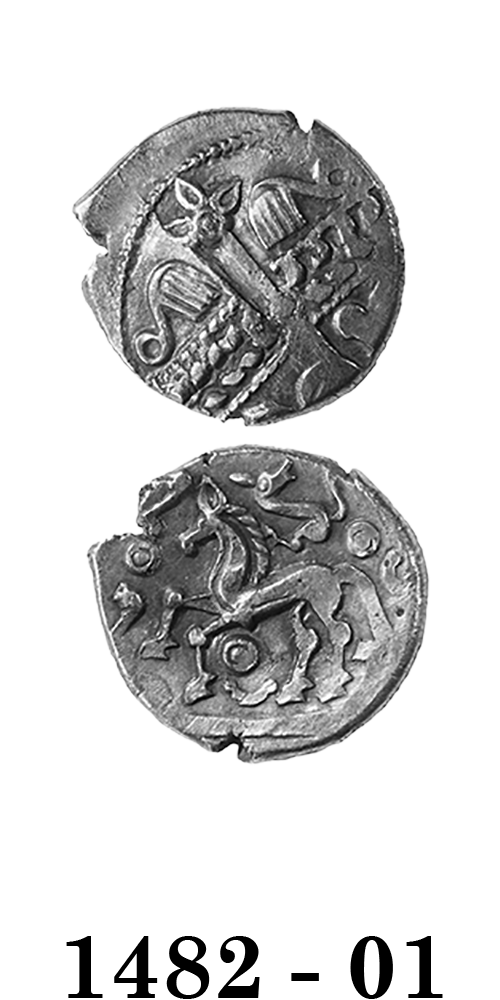
Celtic Coinage of Britain
third edition
Click on coin to see hidden information
Later Trinovantian/Catuvellaunian Uninscribed Coins
Three types of staters appear about the time of Caesar's invasion of 55 B.C., the CLACTON, WALDINGFIELD and NORTHERN WESTERHAM Types.
Originally, the Northern Westerham Type was assigned to the territory of the Atrebates, Regni & Belgae, but John Sills has convincingly argued that it should be reassigned. While it may come to be shown that the Northern Westerham Type should be assigned to the Catuvellauni, and the Clacton and Waldingfield Types to the Trinovantes, the evidence is insufficient to prove this today – there are too few findspots.
Thus, the catalogue here continues the idea that individual coinages for Trinovantes and Catuvellauni cannot be distinguished at the time of the Gallic War, based on the findspot distributions. This does not suggest the two tribes had a unified political structure.
The three earliest types were superseded sometime during the Gallic War by the WHADDON CHASE TYPE. The change signals a reduction in the weight of the stater.
Whaddon Chase Type
A new style of stater was introduced during or after Caesar's invasion of Britain in 55 B.C. The WHADDON CHASE TYPE was struck in several varieties, eventually leading to the first dynastic issue of the Trinovantes/Catuvellauni.
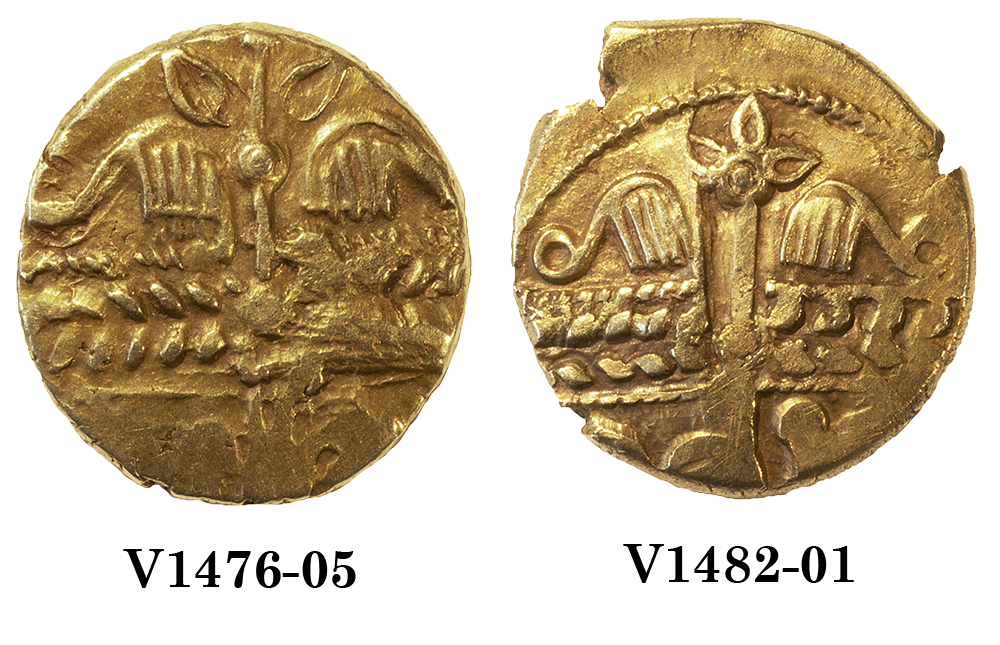
Whaddon Chase Type – Climping Variety
The Whaddon Chase hoard was discovered in 1849, containing many of the familiar coins with a right-facing horse on the reverse. In 1853, Beale Poste published a variety with a left-facing horse. The image in Poste's book is drawn well – certainly well enough to identify the type. Poste was told the coin had been found in Warwickshire, not at Whaddon Chase. He was skeptical of the claimed findspot.
When Evans wrote The Coins of the Ancient Britons in 1864, he declined to list the coin, having not seen it. He acknowledged the possibility that such a type existed. Thus, by 1853, a Whaddon Chase Stater with a left-facing horse was noted and published. The coin has not reappeared and must be lurking unidentified somewhere. It is possible that more of these coins had appeared in 1849 and were either melted down, or lie unattributed and await re-discovery.
The matter was then all but forgotten for almost 150 years (but not by anyone familiar with Poste's work).
Suddenly, in 2000, a "new type" – the "Climping Stater" – was discovered at a metal detector rally at Climping, West Sussex, near Littlehampton. It was immediately described as a variant of the Whaddon Chase Type. The left-facing horse on the reverse was the most noticeable difference.
Ian Leins soon suggested the type was part of the Whaddon Chase series (see Portable Antiquity Scheme records and Littlehampton Museum report). His conclusion – that it was struck north of the Thames – was essentially a sound one. It followed in the footsteps of Poste and Evans. In the system used in this catalogue, the issuing authority would be the Trinovantes/Catuvellauni.
Unfortunately, an attempt was made by others to reattribute the type to the "Regini", solely on the basis of the one reported findspot (Climping). This south-of-the-Thames reattribution placed far too much emphasis on findspot analysis. The workers were perhaps too eager to discover "new" mints and issuing authorities and were tempted to over-interpret the single dot on the map. Worse, they were forced to ignore other sorts of evidence to arrive at their conclusion. This should stand as a cautionary tale for other numismatists.
A detailed die-cutting analysis (Van Arsdell, unpublished) now refutes a West Sussex origin of the type. It is now known that the Climping Stater dies were cut by one of the mint workers for the Whaddon Chase coins. The dies for the Climping Variety and one set of dies for the 1476-05 staters were produced by the same die-cutter. The two coins have the same aesthetic "feel" and style. Details of the imagery show a common workmanship, and specific die-cutting techniques were used for both. Furthermore, the Climping Variety reverse die has the same style and details as a Whaddon Chase quarter stater.
Judging by the plate in Poste's 1853 report, the Climping Variety may be die-linked to the main series by one coin (an obverse die mule). Finding the missing coin would confirm the link.
Ian Leins initial attribution is now seen to be correct – the type can simply be seen as part of the Whaddon Chase series. The finds at Climping merely confirm Poste's 1853 report that such a type exists.
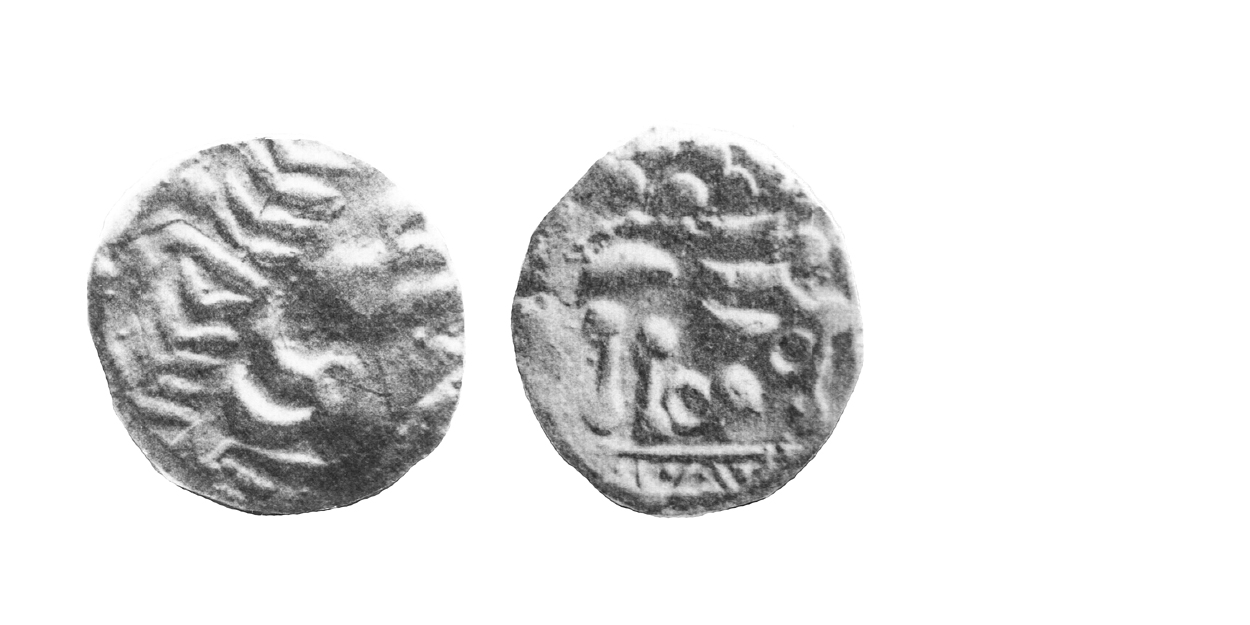
1462 -01 Waldingfield Type
ca. 55 B.C. Extremely Rare
Gold Stater 6.2 gms. 20 mm
Earliest Record: Evans, 1864
OBV: Abstracted head of Apollo right
Identifying ppints:
1) wreath points down
REV: Disjointed horse left
Identifying points:
1) three broad strokes form neck and body of horse
2) beaded mane on horse
3) large pellet and two rings below horse
CLASSIFICATION: Trinovantian C
NOTES:
- Most are in museums
- Typical weight given
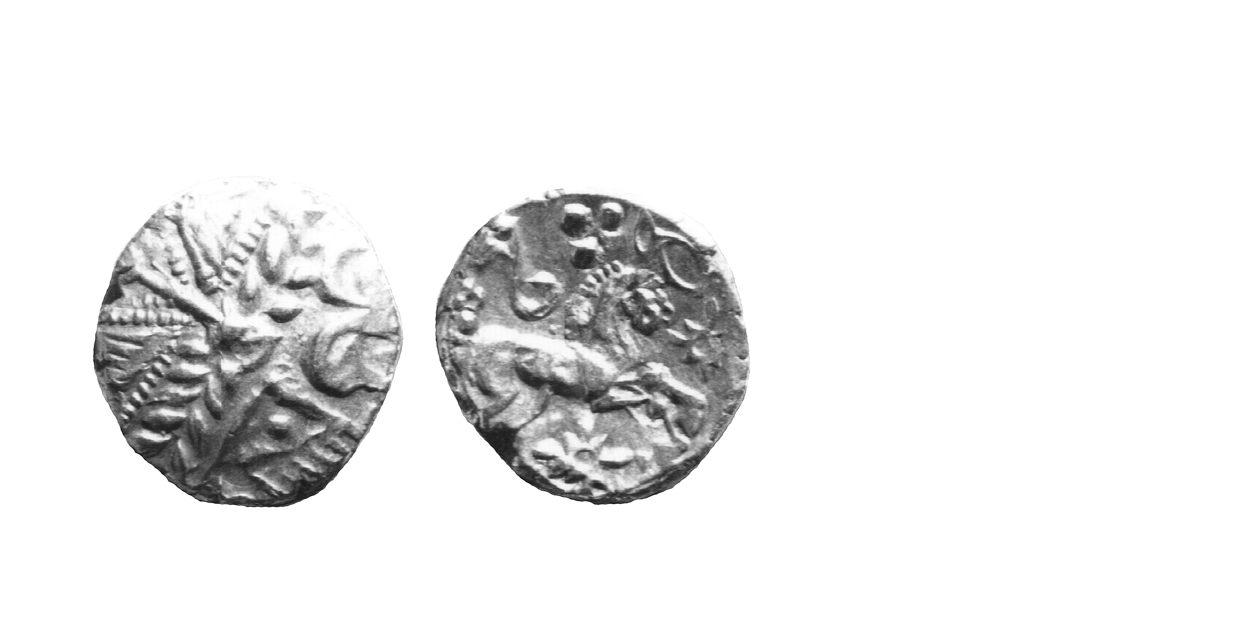
1470 - 01 Whaddon Chase Type
55-45 B.C. Scarce
Gold Stater 5.90 gms. 18 mm
Earliest Record: Evans, 1864
OBV: Abstracted head of Apollo right
Identifying points:
1) spike made up of line with a pellet at either end
2) two wing-like objects on either side of spike to left of wreath
REV: Romanized horse right
Identifying points:
1) cog wheel with teeth of unequal length below horse
2) same cog wheel in front of horse's head
3) winged object above horse
4) ellipse in front of and behind horse
5) "X" behind horse
6) horse has oversized ear
CLASSIFICATION: Trinovantian D
NOTES:
- Winged object and "X" near the horse are copied directly from the winged-head Roma type denarius of the Roman Republic
- Standard Weight given
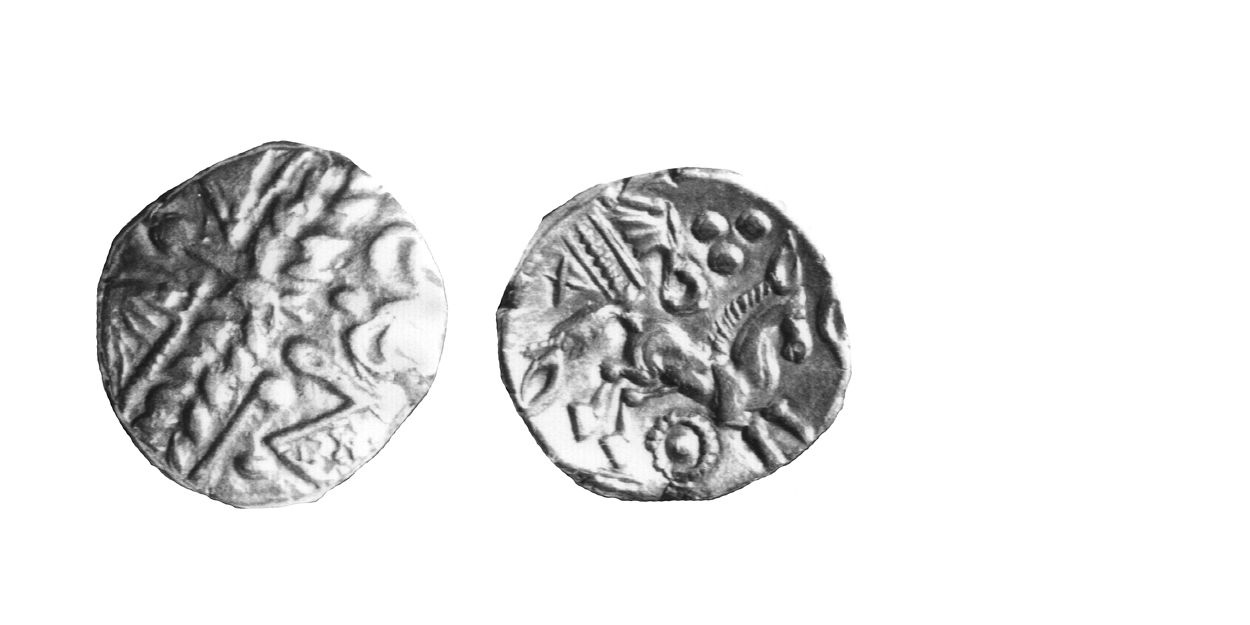
1472 - 01 Whaddon Chase Type
55-45 B.C. Rare
Gold Stater 5.90 gms. 19 mm
Earliest Record: Poste, 1853
OBV: Abstracted head of Apollo right
Identifying points:
1) spike made up of line with a pellet at either end
2) two wing-like objects on either side of spike to left of wreath
REV: Romanized horse right
Identifying points:
1) sunflower below horse
2) winged object above horse
3) row of pellets enclosed in two parallel lines near winged object
4) ellipse with row of pellets in front of and behind horse
6) "X" behind horse
7) horse has oversized ear
CLASSIFICATION: Trinovantian D
NOTES:
- Winged object and "X" near the horse are copied directly from the winged-head Roma type denarius of the Roman Republic
- Celtic Coin Index records now indicate rarer than previously thought
- Standard Weight given
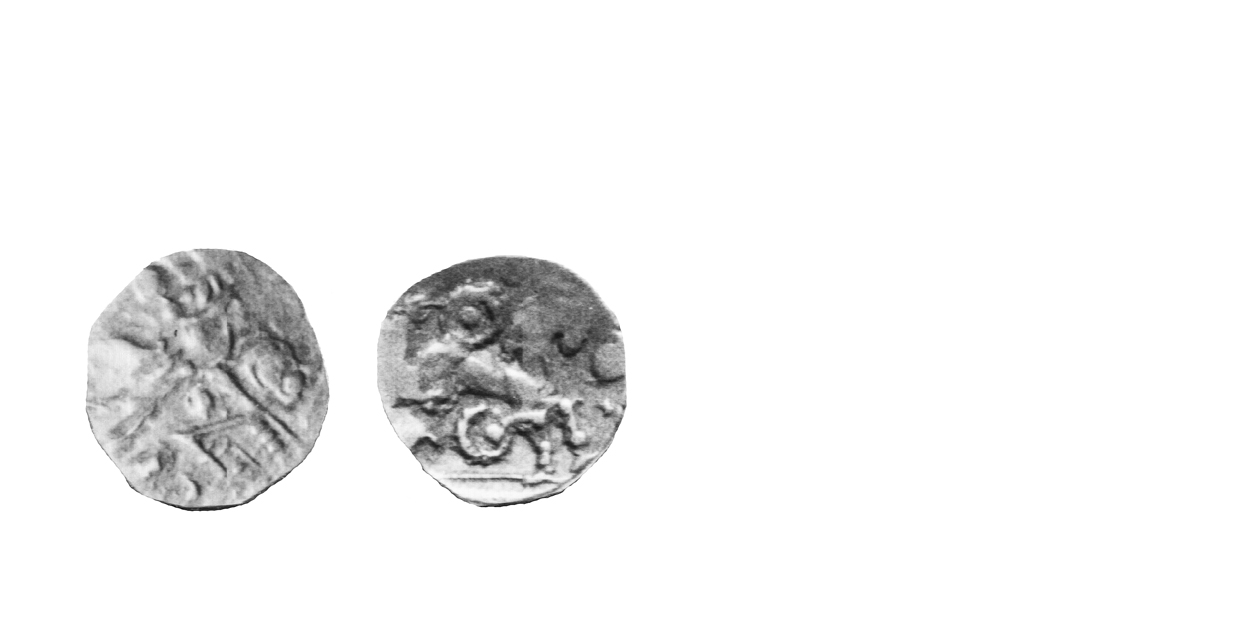
1474 - 01 Whaddon Chase Type
55-45 B.C. Extremely Rare
Gold Quarter Stater ca. 1.25 gms. 14 mm
Earliest Record: Allen, 1960
OBV: Abstracted head of Apollo right
Identifying points:
1) spike made up of line and pellet
2) two wing-like objects on either side of spike to left of wreath
REV: Romanized horse right
Identifying points:
1) sunflower above horse
2) sunflower below horse
3) horse has oversized ear
CLASSIFICATION: Trinovantian D
NOTES:
- Typical weight given
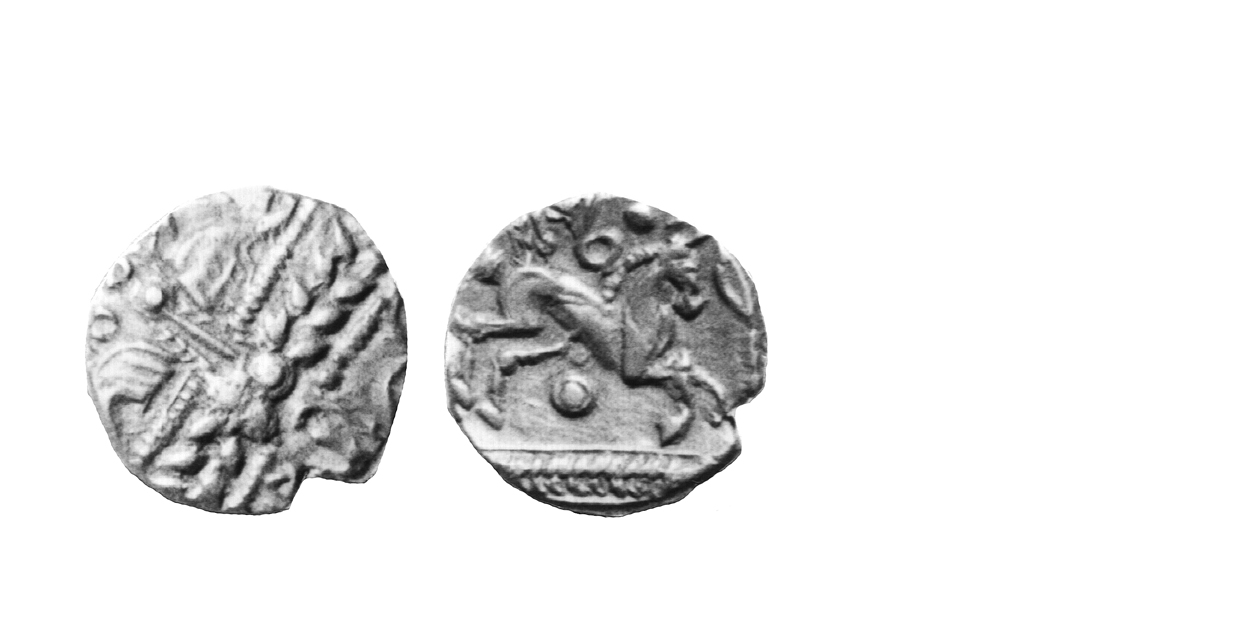
1476 - 01 Whaddon Chase Type
55-45 B.C. Common
Gold Stater 5.90 gms. 17-18 mm
Earliest Record: Van Arsdell, 1989
OBV: Abstracted head of Apollo right
Identifying points:
1) spike made up of line with a pellet at either end
2) two wing-like objects on either side of spike to left of wreath
REV: Romanized horse right
Identifying points:
1) ring-and-large-pellet motif below horse
2) winged object above horse
3) ellipse with row of pellets in front of horse
4) ellipse behind horse
5) horse has oversized ear
CLASSIFICATION: Trinovantian D
NOTES:
- Winged object near the horse is copied directly from the winged-head Roma type denarius of the Roman Republic
- Modern forgeries of the 1476 type exist – (see 1476 - 03F)
- Standard Weight given
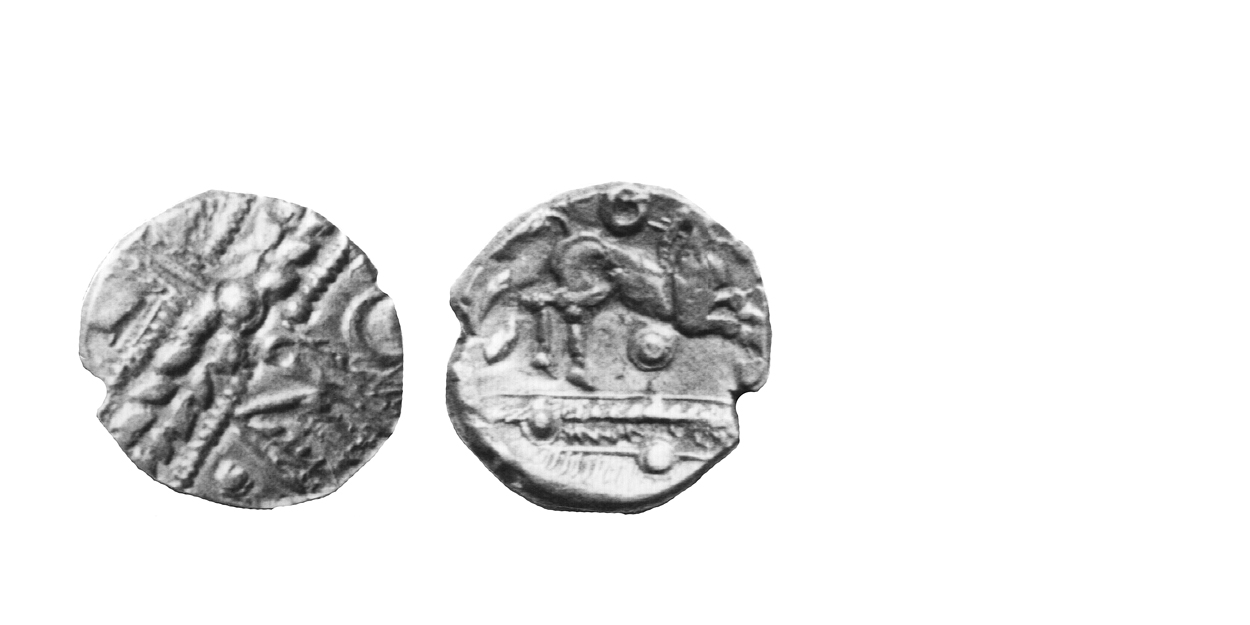
1476 - 01 Whaddon Chase Type
55-45 B.C. Common
Gold Stater 5.90 gms. 17-18 mm
Earliest Record: Van Arsdell, 1989
OBV: Abstracted head of Apollo right
Identifying points:
1) spike made up of line with a pellet at either end
2) two wing-like objects on either side of spike to left of wreath
REV: Romanized horse right
Identifying points:
1) ring-and-large-pellet motif below horse
2) winged object above horse
3) ellipse with row of pellets in front of horse
4) ellipse behind horse
5) horse has oversized ear
CLASSIFICATION: Trinovantian D
NOTES:
- Winged object near the horse is copied directly from the winged-head Roma type denarius of the Roman Republic
- Modern forgeries of the 1476 type exist – (see 1476 - 03F)
- Standard Weight given
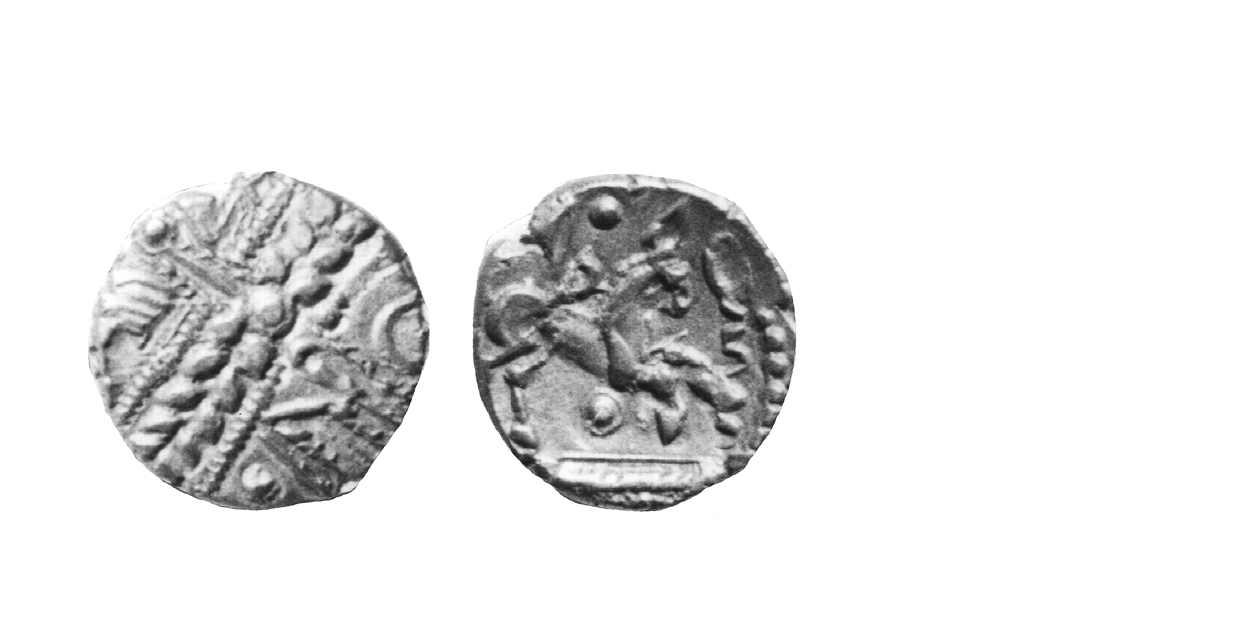
1476 - 03 Whaddon Chase Type
55-45 B.C. Common
Gold Stater 5.90 gms. 17-18 mm
Earliest Record: Evans, 1864
OBV: Abstracted head of Apollo right
Identifying points:
1) spike made up of line with a pellet at either end
2) two wing-like objects on either side of spike to left of wreath
REV: Romanized horse right
Identifying points:
1) ring-and-large-pellet motif below horse
2) winged object above horse
3) ellipse with meandering line in front of horse
4) ellipse behind horse
5) horse has oversized ear
CLASSIFICATION: Trinovantian D
NOTES:
- Winged object near the horse is copied directly from the winged-head Roma type denarius of the Roman Republic
- Standard Weight given
- Modern forgeries of the 1476 type exist – (see 1476 - 03F)
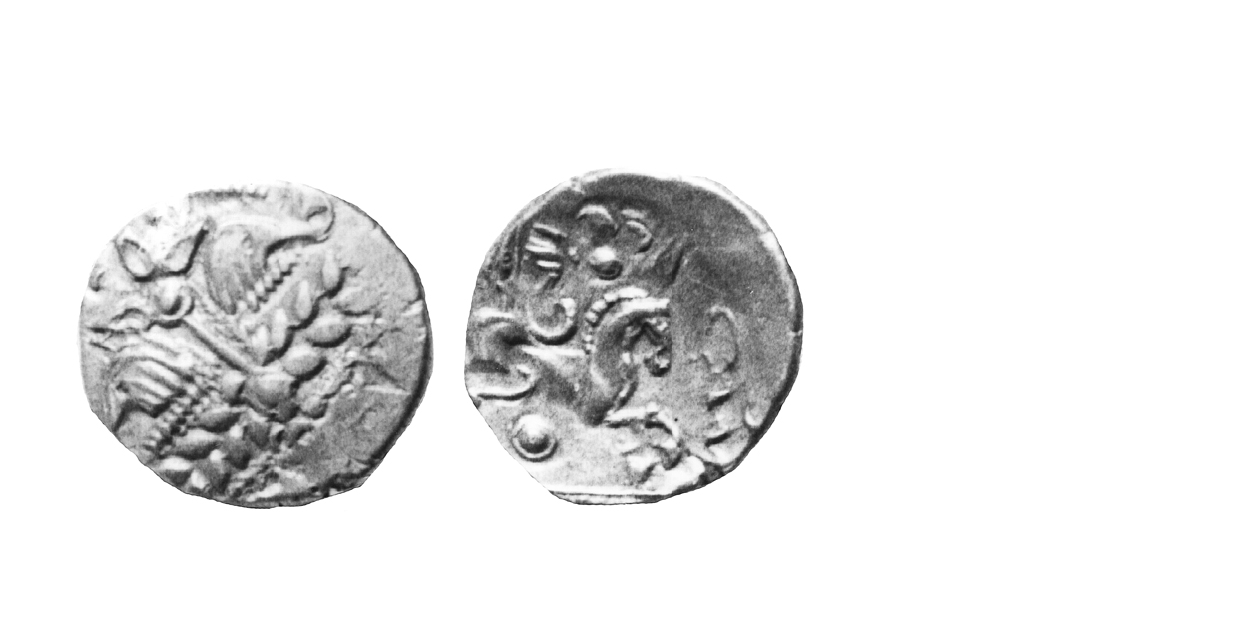
1476 - 03 Whaddon Chase Type
55-45 B.C. Common
Gold Stater 5.90 gms. 17-18 mm
Earliest Record: Evans, 1864
OBV: Abstracted head of Apollo right
Identifying points:
1) spike made up of line with a pellet at either end
2) two wing-like objects on either side of spike to left of wreath
REV: Romanized horse right
Identifying points:
1) ring-and-large-pellet motif below horse
2) winged object above horse
3) ellipse with meandering line in front of horse
4) ellipse behind horse
5) horse has oversized ear
CLASSIFICATION: Trinovantian D
NOTES:
- Winged object near the horse is copied directly from the winged-head Roma type denarius of the Roman Republic
- Standard Weight given
- Modern forgeries of the 1476 type exist – (see 1476 - 03F)
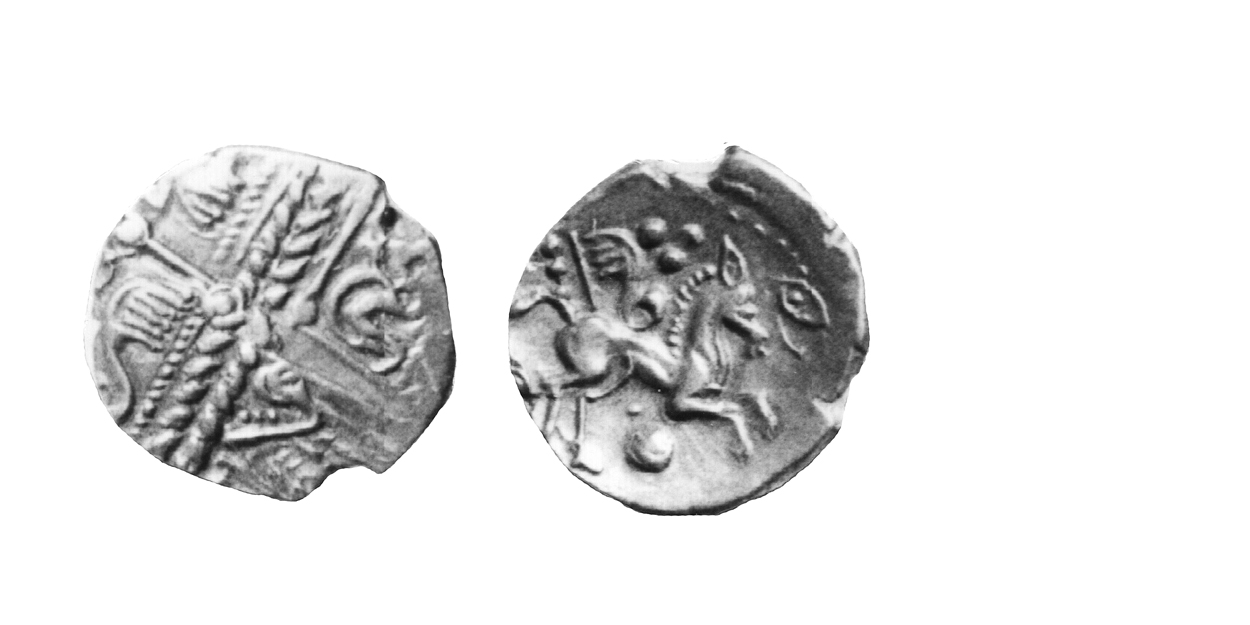
1476 - 05 Whaddon Chase Type
55-45 B.C. Common
Gold Stater 5.90 gms. 17-18 mm
Earliest Record: Van Arsdell, 1989
OBV: Abstracted head of Apollo right
Identifying points:
1) spike made up of line with a pellet at either end
2) two wing-like objects on either side of spike to left of wreath
REV: Romanized horse right
Identifying points:
1) ring-and-large-pellet motif below horse
3) uncertain animal or fish head with row of pellets in front of horse
2) winged object above horse
4) ellipse behind horse
5) horse has oversized ear
CLASSIFICATION: Trinovantian D
NOTES:
- Winged object near the horse is copied directly from the winged-head Roma type denarius of the Roman Republic
- Modern forgeries of the 1476 type exist – (see 1476 - 03F)
- Standard Weight given
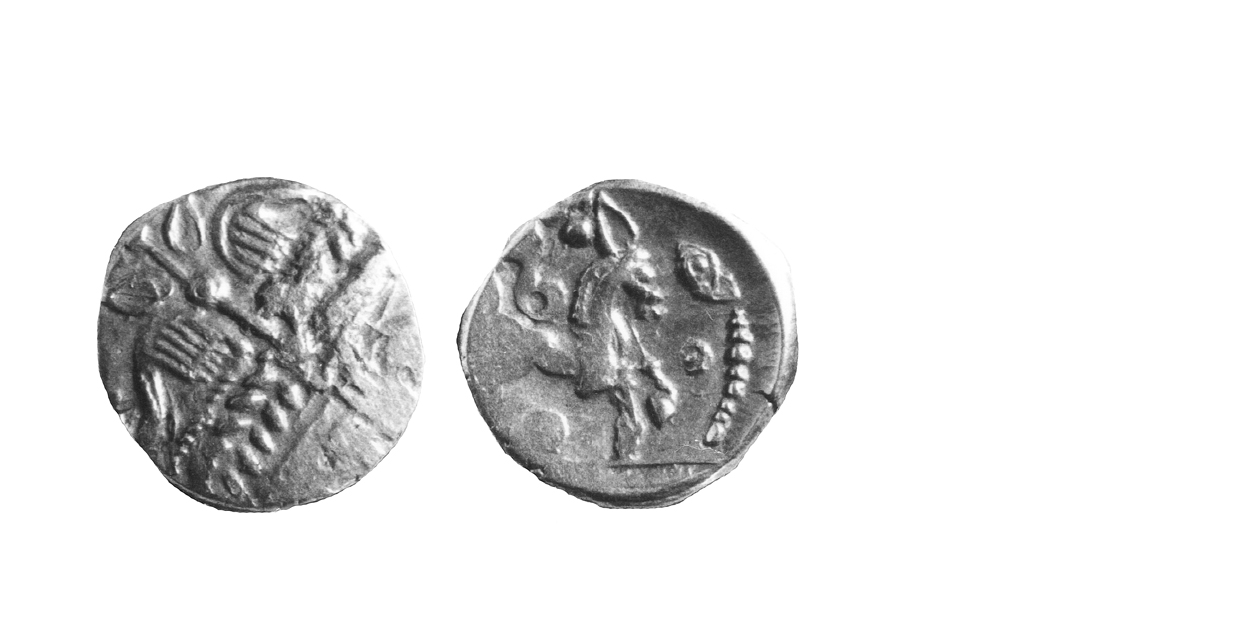
1476 - 05 Whaddon Chase Type
55-45 B.C. Common
Gold Stater 5.90 gms. 17-18 mm
Earliest Record: Van Arsdell, 1989
OBV: Abstracted head of Apollo right
Identifying points:
1) spike made up of line with a pellet at either end
2) two wing-like objects on either side of spike to left of wreath
REV: Romanized horse right
Identifying points:
1) ring-and-large-pellet motif below horse
3) uncertain animal or fish head with row of pellets in front of horse
2) winged object above horse
4) ellipse behind horse
5) horse has oversized ear
CLASSIFICATION: Trinovantian D
NOTES:
- Winged object near the horse is copied directly from the winged-head Roma type denarius of the Roman Republic
- Modern forgeries of the 1476 type exist – (see 1476 - 03F)
- Standard Weight given
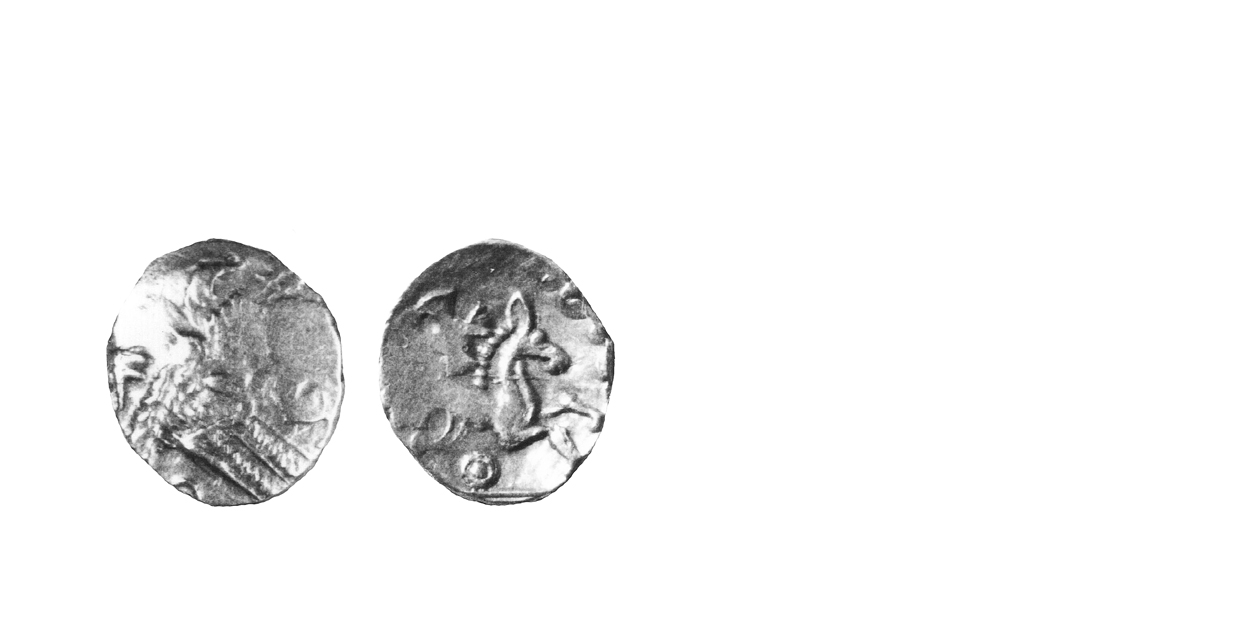
1478 - 01 Whaddon Chase Type
55-45 B.C. 1.30 gms. Extremely Rare
Gold Quarter Stater 14 mm
Earliest Record: Van Arsdell, 1989
OBV: Abstracted head of Apollo right
Identifying points:
1) spike made up of line and pellets
2) two wing-like objects on either side of spike to left of wreath
3) wreath is bent at an angle at the point it intersects the spike
REV: Romanized horse right
Identifying points:
1) ring-and-large-pellet motif below horse
2) Maltese cross-like object above horse
3) horse has oversized ear
CLASSIFICATION: Trinovantian D
Notes:
- Weight of existing coin given
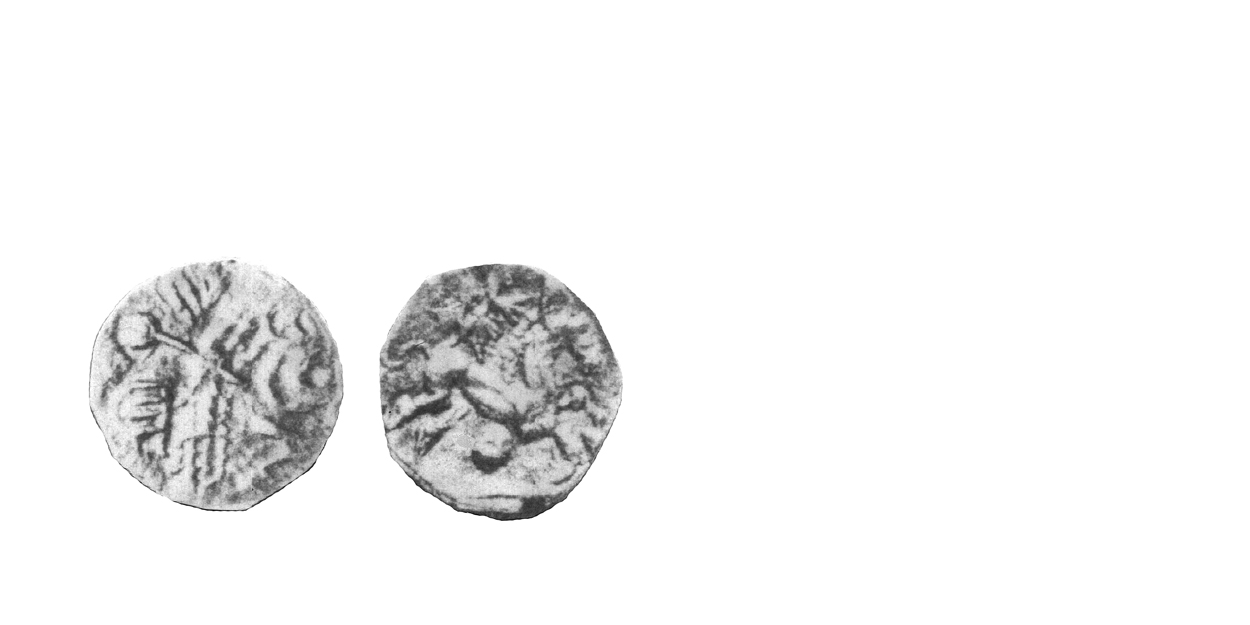
1478 - 03 Whaddon Chase Type
55-45 B.C. Extremely Rare
Gold Quarter Stater 13 mm
Earliest Record: Van Arsdell, 1989
OBV: Abstracted head of Apollo right
Identifying points:
1) spike made up of line and pellets
2) two wing-like objects on either side of spike to left of wreath
3) wreath is bent at an angle at the point it intersects the spike
REV: Romanized horse right
Identifying points:
1) large pellet below horse
2) flower made up of lines above horse
3) horse has oversized ear
CLASSIFICATION: Trinovantian D
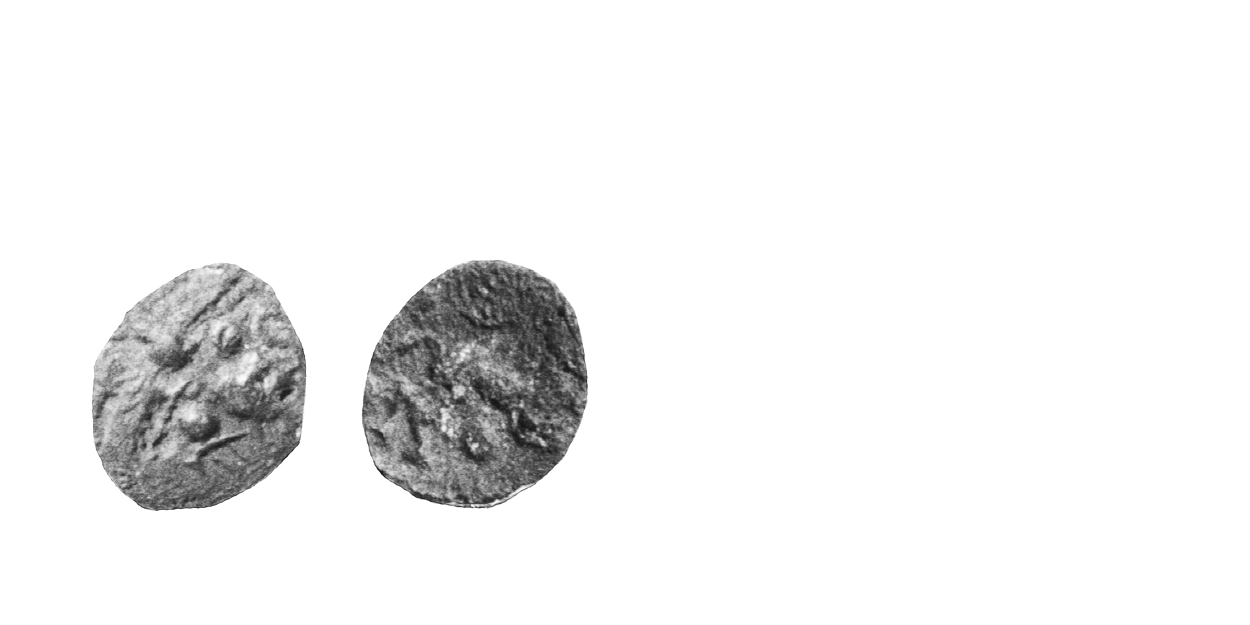
1478 - 05 Whaddon Chase Type
55-45 B.C. Extremely Rare
Gold/Bronze Quarter Stater 14 mm
Earliest Record: Van Arsdell, 1989
OBV: Abstracted head of Apollo right
Identifying points:
1) spike made up of line and pellets
2) two wing-like objects on either side of spike to left of wreath
3) wreath is bent at an angle at the point it intersects the spike
REV: Romanized horse right
Identifying points:
1) large pellet below horse
2) flower made up of lines above horse
3) horse has oversized ear
CLASSIFICATION: Trinovantian D
NOTES:
- Bronze core of a plated quarter, an ancient forgery of 1478 - 03
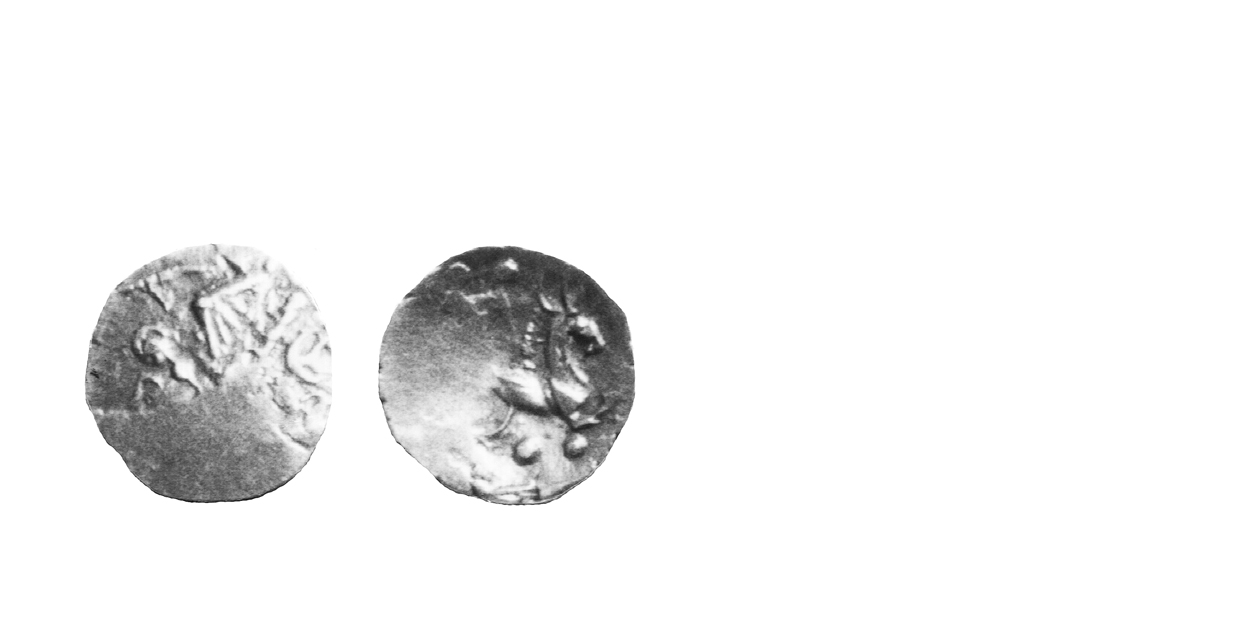
1478 - 07 Whaddon Chase Type
55-45 B.C. Extremely Rare
Gold Quarter Stater 13 mm
Earliest Record: Van Arsdell, 1989
OBV: Abstracted head of Apollo right
Identifying points:
1) spike made up of line and pellets
2) two wing-like objects on either side of spike to left of wreath
3) wreath is bent at an angle at the point it intersects the spike
REV: Romanized horse right
Identifying points:
1) large pellet below horse
2) flower made up of lines above horse
3) horse has oversized ear
4) two pellets below horse
CLASSIFICATION: Trinovantian D
NOTES:
- Most are in museums
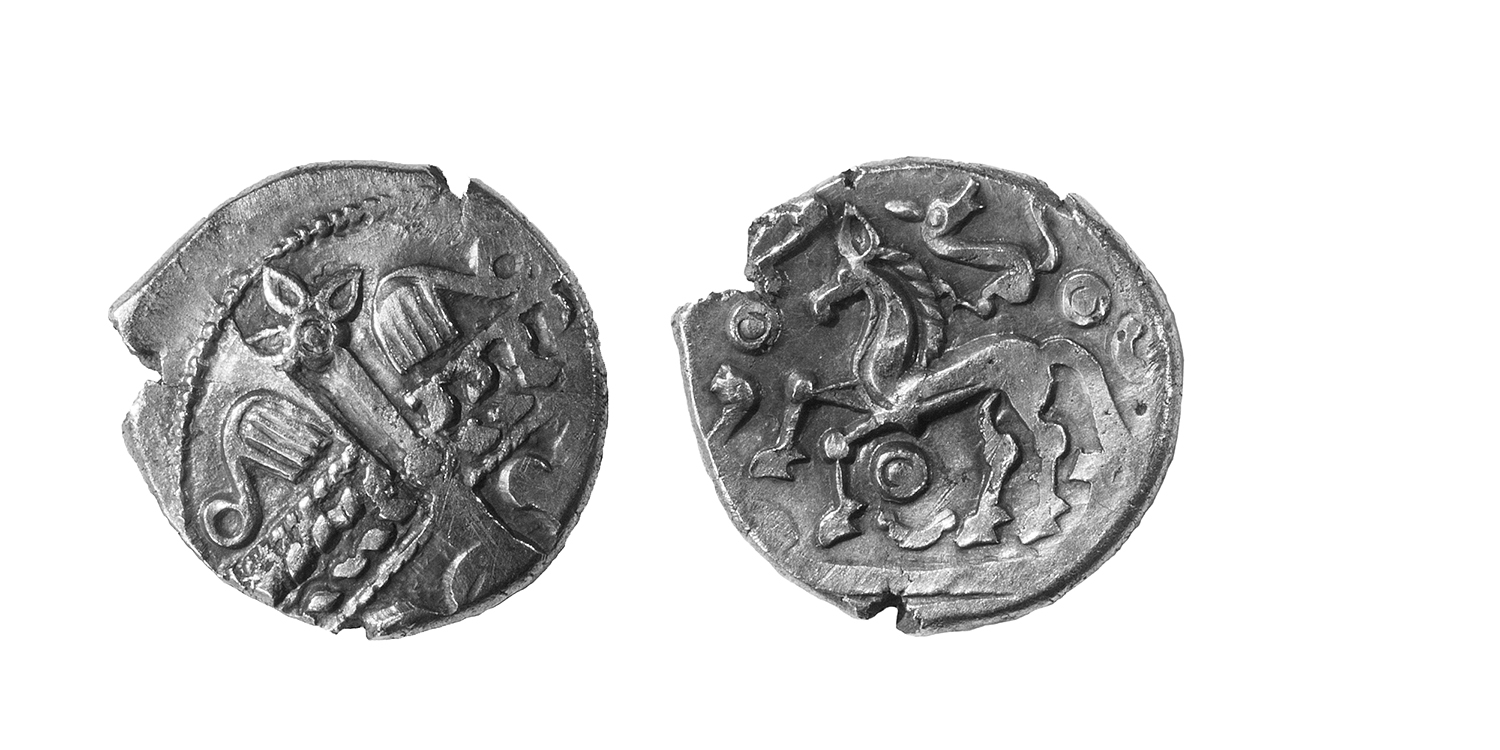
1482-01 Whaddon Chase Type
Climping Variety
55-45 B.C. Scarce
Gold Stater 5.36-5.75 gms. ca. 18-19mm
Earliest Record: Poste, 1853
OBV: Abstracted head of Apollo right
Identifying points:
1) spike made up of line with a pellet at either end
2) spike has three leaves at upper end, similar to the ear of the horse
3) two wing-like objects on either side of spike to left of wreath, identical in style to those on 1476 - 05
4) wreath ears point down
REV: Romanized horse left
Identifying points:
1) ring-and-large-pellet motif below horse
2) uncertain animal or dragon in front of horse
3) uncertain animal or dragon above horse
4) crescent with pellet ends below horse, near exergue
5) ring-and-large-pellet motif above horse's tail
6) horse has oversized ear
CLASSIFICATION: Trinovantian D
NOTES:
- Finds of this type at Climping confirm Poste's 1853 report of the type
- Poste's plate coin appears to have an obverse die-link to the rest of the Whaddon Chase series
- The Poste plate coin cannot be traced today and would be an important rediscovery if located
- Ian Leins correctly identified the type as Trinovantian/Catuvellaunian in early 2000's
- Later attempts to reassign it to the "Regini", based on the single known findspot, are incorrect
- Rarity estimate follows suggestion of Ian Leins
- Many in museums
- Typical weight range given
- Too few weights are recorded to estimate the Standard Weight, but likely to be similar to the rest of the Whaddon Chase series
- Dies cut by same die-cutter as 1476-05 (another) and 1478-01
Coinage of the Trinovantes/Catuvellauni
Traditionally, the Trinovantes and Catuvellauni were considered distinct tribes, each with its own coinage. An elaborate history, written from the coin inscriptions, described a long intertribal warfare. The Trinovantes received blow after devastating blow from the warlike Catuvellauni and lost Camulodunum, their tribal capital, several times in the process. The evidence was founded partially on Caesar's writings – the ruler of the Trinovantes had been killed by Cassivellaunus. Cassivellaunus was assumed to be a ruler of the Catuvellauni, though Caesar never stated so. The rest of the support came from an analysis of the findspots of the Dynastic coins.
Today, this history is considered a myth – the coin evidence no longer supports continual internecine warfare north of the Thames. Cassivellaunus' tribal origin is not mentioned by any contemporary writer and there is no indication he was the ruler of the Catuvellauni. The similarity of the tribal and personal names is coincidence, not a link between the two. Furthermore, recent analyses of the findspot distributions indicate the coins circulated farther afield than previously thought. The territory north of the Thames can no longer be separated into two distinct coin-using zones.
Instead, the coinage is seen today as that of a single economic group – coin types appear in succession and circulate not only throughout the area immediately north of the Thames, but into Icenian and Cantian territory as well. Metrology and typology show the inscriptions on the dynastic issues are those of successive rulers, not contemporary adversaries.
In general, the picture today is of a powerful, united tribe occupying the area north of the Thames. The unification must have occurred shortly before the Gallic War, or during it. This unified tribe had economic influence beyond its borders which increased throughout the period of the coinage. The tribal group ultimately controlled the economy of the Cantii, and to a lesser extent the economies of the Iceni and Atrebates/Regni/Belgae.
But what was this group group?
That two tribes existed is not in doubt. Caesar mentions the Trinovantes in his Gallic War commentaries, stating they were probably the most powerful tribe in southern Britain. The Catuvellauni are mentioned on an inscribed Roman stone from Hadrian's wall. There were two minting centres in the territory, at the tribal oppida of Verulamium and Camulodunum, suggesting two political centres existed. However, the coinage is a unified one since the two tribal groups must have merged into a single economic unit before they started producing coins. As a result, the tribes cannot be distinguished numismatically, and they are referred to as the Trinovantes/Catuvellauni. For all practical purposes, by the introduction of the Whaddon Chase Type about 55 B.C., they had come to act as one economically, and perhaps had been doing so as early as 125 B.C. The inscribed coinage argues for political unity by 40 B.C. as well. The dynastic coins show an orderly succession of rulers, except for a brief period around the turn of the millenium. This appears to have been an Interregnum, during which the succession was disputed.
The Trinovantes/Catuvellauni occupied the entire territory immediately north of the Thames. They were bounded on the north-east by the Iceni, on the south by the Cantii and Atrebates/Regni/Belgae, on the north the by the Corieltauvi, and on the west, probably, by the Dobunni. Thus, they were in physical contact with all the tribes of the south-east, and in a position to exert influence.
By 125 B.C.. they were importing coins from the Ambiani on the Continent, and shared the cross-Channel trade with the Cantii and Atrebates/Regni. Large Flan, Defaced Die and Abstract Type gold coins are found throughout their territory in quantity.
When the Cantii began casting bronze coins about 100 B.C., the Trinovantes/Catuvellauni followed this lead and produced their own cast coinage for a brief period. In the early 1980s a small hoard of unusual cast bronze coins was dispersed in Europe, about 100 to 300 pieces with an alleged 'Folkestone findspot'. At first this was dismissed as incorrect, and the coins branded Gaulish. However, during the late summer of 1987 a hoard of about 2,000 cast bronzes, including the unusual type, were found in a pit in the vicinity of West Thurrock, Essex. The coins occurred in at least sixteen varieties, with a reasonable typological progression. One coin had a large protrusion of flash which would have broken off had the coin been moved any great distance. In general, the hoard appeared to be made up of coins collected by a mint, perhaps for remelting. No other evidence of minting activity was noted at the site, but it appears the mint cannot have been far away.
THURROCK TYPE cast bronzes are also found as single finds in Essex. A few have been found in the Thames River and one coin was found in Dorset. Many single finds and one small hoard have been found in Kent, prompting some to the conclusion they are a Kentish issue. The coins cannot have been used for a very long time. Three interpretations are likely: 1) they have a Gaulish origin and were briefly imported, 2) they have a British origin and represent the first coinage of the Trinovantes/Catuvellauni, or 3) they are a Kentish issue. Although similar coins are reported from the Continent (Castelin, 1978, numbers 477 to 485), they are not sufficiently alike to have a common Gaulish origin. Thus, of the three interpretations, the Gaulish origin appears the least likely. The Thurrock Hoard, representing a complete corpus of the series, would have been very difficult to assemble outside the mint – it very well may be a hoard of mint scrap. Thus, the suggestion here is that the Thurrock Hoard was produced in the vicinity of the findspot – the coins representing a Trinovantian/Catuvellaunian issue.
Thurrock Types appear to have been influenced by the Prototype Period cast bronzes of the Cantii, dating them about l00 to 90 B.C. Within twenty years, the tribe was striking its own gold coinage.
The Trinovantes/Catuvellauni were one of the earliest tribes to begin striking gold staters, with the introduction of the CLACTON and NORTHERN WESTERHAM TYPES around 70-60 B.C. A hoard of the CLACTON TYPES was found with Ambiani Abstract Type staters at Clacton beach. This type, like all the early types struck in Britain was, short-lived – submerged by the large influx of Gallic War staters. About the middle of the war, the tribe began to strike the WHADDON CHASE TYPE, and continued to produce coins until the Claudian invasion a hundred years later.
The Trinovantes/Catuvellauni apparently collaborated with the Romans during the War. They probably did this by hampering trade between the Durotriges and the Armorican tribes, by competing for supplies within Britain. They may have delivered supplies directly to the Roman army, as well. The tribe obtained a large amount of gold for this effort and evidently became the recipient of wine-trading rights with the Romans. This favour ultimately gave the tribe an economic superiority over all the other tribes in the southeast after the war.
The tribe operated two mints, one at Verulamium, the other at Camulodunum. Initially, the Verulamium mint produced most of the coins, but it was overshadowed by Camulodunum in the first century A.D. The remains of both mints have been found during archaeological excavations.
It has long been asserted that Caesar gave coin-manufacturing assistance during his visit in 54 B.C., because the coins of the period display Romanizing influences. Training was probably unnecessary, however, because the moneyers would have been expert metal-workers already. The die-cutting on Whaddon Chase staters is excellent, but surprisingly, the dies were cut in soft metal. They broke up quickly and many of the existing pieces show die-damage. Sometimes depressions appear where the die surface heaved up during punching. Normally, the heaved surfaces would have been planed off, but this was not done for some reason. All this suggests that the minting was hurried, not unusual for a time of war.
